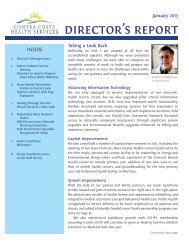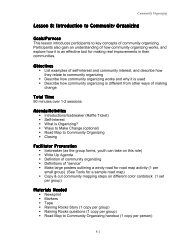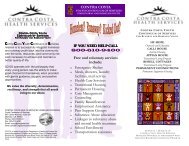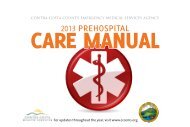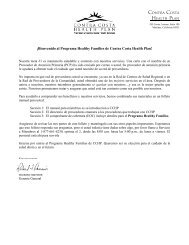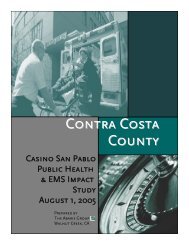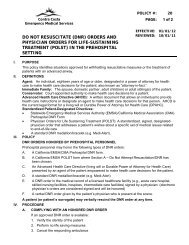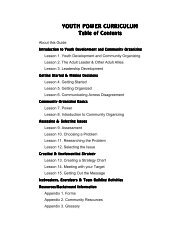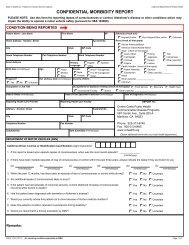EMS Policy Manual - Contra Costa Health Services
EMS Policy Manual - Contra Costa Health Services
EMS Policy Manual - Contra Costa Health Services
Create successful ePaper yourself
Turn your PDF publications into a flip-book with our unique Google optimized e-Paper software.
<strong>Contra</strong> <strong>Costa</strong><br />
Emergency Medical <strong>Services</strong><br />
POLICY #: 15<br />
PAGE: 2 of 4<br />
Generally used for routine interfacility transport of patients with minimal care needs.<br />
Level of care may be enhanced by personnel and equipment provided by sending facility<br />
for needs beyond EMT-I scope of practice.<br />
2. Critical Care Transport Paramedic Ambulance (CCT-P)<br />
Provides paramedic level service with an extended paramedic scope of practice<br />
(CCT-P). Refer to scope of practice matrix on page three.<br />
Arrival time based on availability.<br />
Provides one CCT Paramedic as caregiver.<br />
Private ambulance agencies may provide this care.<br />
Guidelines for any treatment administered by paramedics are determined by <strong>Contra</strong><br />
<strong>Costa</strong> <strong>EMS</strong> policy and procedures.<br />
Generally used for routine interfacility transport of patients whose needs are not highly<br />
complex and are within the available scope of practice.<br />
3. Critical Care Transport Ambulance with RN Staffing<br />
Provides advanced care for patients with complex medical needs.<br />
The scope of practice of nursing or physician personnel is determined by the ambulance<br />
provider agency.<br />
Arrival time based on availability.<br />
Numerous private ambulance providers offer this level of service.<br />
Specialty transports for pediatric and obstetric patients are also available.<br />
4. Air Ambulance<br />
Provides RN-level of care for patients with complex medical needs.<br />
Arrival time based on availability.<br />
In situations where receiving hospital is distant, may provide most rapid mode of<br />
transport.<br />
Specialty transports for pediatric and obstetric patients are also available.<br />
III. PROCEDURES TO ARRANGE ACUTE CARE INTERFACILITY TRANSFER<br />
A. Interfacility Emergency Response (Emergency Paramedic Ambulance Transport) – For a<br />
patient who requires emergency transfer (needing immediate care or intervention at the receiving<br />
facility – e.g. critical trauma or ST-elevation myocardial infarction):<br />
1. Assure appropriate indication for use. Emergency ambulance transport utilizes 9-1-1<br />
resources and is reserved for truly emergent cases.<br />
2. Arrange for transfer with receiving facility personnel.<br />
3. Assess patient needs in transport to determine if patient needs exceed paramedic<br />
scope of care. If beyond paramedic scope, hospital will need to provide personnel and<br />
equipment to accompany patient (e.g. if IV pump needed, blood transfusion in progress,<br />
management of paralytic agents for intubated patient).<br />
4. Have records (and staff and equipment, if necessary) prepared for transport. The<br />
ambulance will generally arrive within 10 minutes of request and patient should be ready for<br />
transport. If delays occur, the 9-1-1 ambulance may be reassigned for other emergency<br />
needs. If additional records are not available, they can be faxed or transported separately.<br />
5. Call 9-1-1 to request “Interfacility Emergency Response.” Exception: For San Ramon<br />
Medical Center, contact San Ramon Valley Fire Protection District Communication Center.<br />
*NOTE: The information in the above section is contained in the INTERFACILITY<br />
EMERGENCY RESPONSE worksheet



